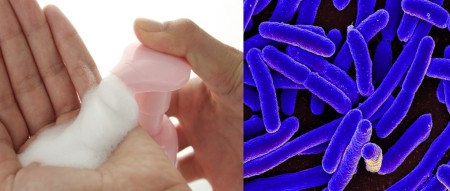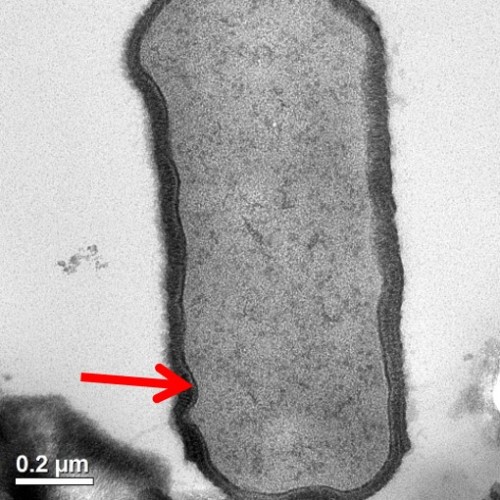Think about the last time you cooked meat, wiped down a countertop with Lysol, or used hand sanitizer. You already know that these actions will help to kill bacteria that might make you sick, but wouldn’t it be nice if you could easily tell whether your efforts had been effective—that is, how many of the bacteria you were trying to kill are actually dead? Scientists have developed tools that can be used in the laboratory to answer this question. We in the Center for Sustainable Nanotechnology (CSN) make particular use of one such tool, called the Live/Dead® BacLight™ assay,1 to study if and how nanoparticles kill bacteria. Unfortunately, this tool doesn’t allow us to distinguish between good bacteria and harmful bacteria, so it would be impractical to use it to check for bacteria in your food, on your counter, or on your hands. It also requires the use of some specialized equipment, so for now it is just an extremely useful tool for research purposes.2

The Live/Dead BacLight assay doesn’t directly tell you if bacteria are living or dead, but it provides information about the status of the bacterial cell membrane, which is a really good indicator. The cell membrane is a very important structure to bacterial cells (and to all cells, for that matter) because it serves as a barrier to separate the inside of the cell from the outside world; it regulates what enters and exits the cell and prevents the inner cell contents from leaking out into the surrounding environment. (We’ve talked about the cell membrane a lot on the blog before, such as here and here.) Since the cell membrane is so important for bacterial survival, cells that have damaged membranes are considered to be dead. In Figure 2, you can see an image of a real bacterial cell (that I took!) with a clearly visible cell membrane shown by a red arrow.

Scientists at the CSN are interested in determining if and how different nanoparticles kill bacteria. After we expose the bacteria to nanoparticles, we use the LIVE/DEAD BacLight assay kit to see how many bacteria have been killed. This kit contains two dyes, one called SYTO® 9 and another called propidium iodide. Both of these dyes don’t do much when they are outside of bacterial cells, but they emit light (fluoresce) when they bind to DNA inside the cell. SYTO 9 passes through the cell membrane of bacteria easily and fluoresces green when a certain wavelength of light shines on it. Propidium iodide, on the other hand, can only enter bacteria with damaged cell membranes. When propidium iodide makes its way into cells with damaged membranes, it pushes out SYTO 9, replacing green fluorescence with red fluorescence.1
So, once a group of bacteria have been treated with these two dyes, live bacteria appear green and dead bacteria appear red. But we can’t observe this effect with our unaided eyes, mostly because bacteria are so small. Instead we look for the amount of green and red fluorescence (i.e., the number of live and dead bacterial cells) using either a microscope or a fluorescence spectrometer, an instrument that shines light on the bacteria and monitors fluorescence. Figure 3 shows an example image taken using a fluorescent microscope, in which the bacteria can be seen to be either green or red.

As you can see, this kit makes it very easy to determine if bacteria are alive or if they are dead. Unfortunately, this kit does not work for all of the experiments we perform in the Center for Sustainable Nanotechnology. Sometimes the nanoparticles that we expose bacteria to interfere with our ability to see the green and red fluorescence from these dyes, or they disturb how these dyes interact with bacterial cells. When we run into such issues, we look to other techniques to determine if and how nanoparticles kill bacteria. We will cover more of these techniques in another blog post soon!
Note: Although the author has experience using the product discussed here, this post is intended for educational purposes only. The author, Sustainable-Nano.com, and the Center for Sustainable Nanotechnology have not received any compensation for writing this post, and we have no material connection to Thermo Fisher or the products mentioned.
EDUCATIONAL RESOURCES
- Bacteria Virtual Lab Lesson Plan: Gram Staining Simulation (grades 6-12)
- Bacteria, Microbes and Germs….Oh my!
- LIVE/DEAD BacLight Bacterial Viability Kits. ThermoFisher Scientific Inc. Product Information. Revised July 15, 2004.
- Maurer-Jones, M.A.; Gunsolus, I.L.; Murphy, C.J.; Haynes, C.L. Toxicity of Engineered Nanoparticles in the Environment. Anal. Chem. 2013, 85, 3036-3049. DOI: 10.1021/ac303636s
